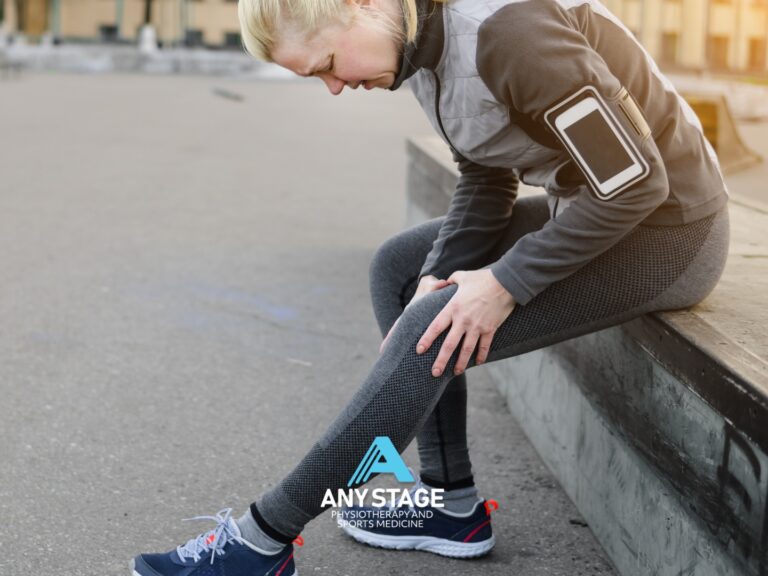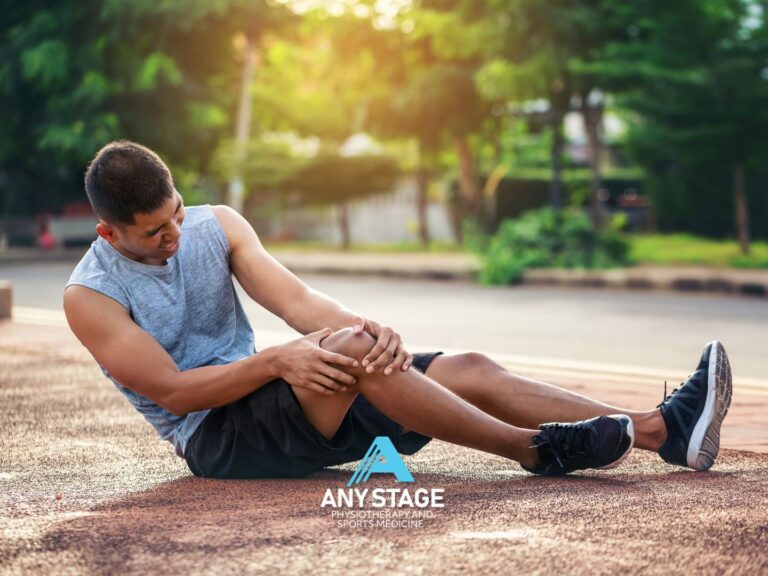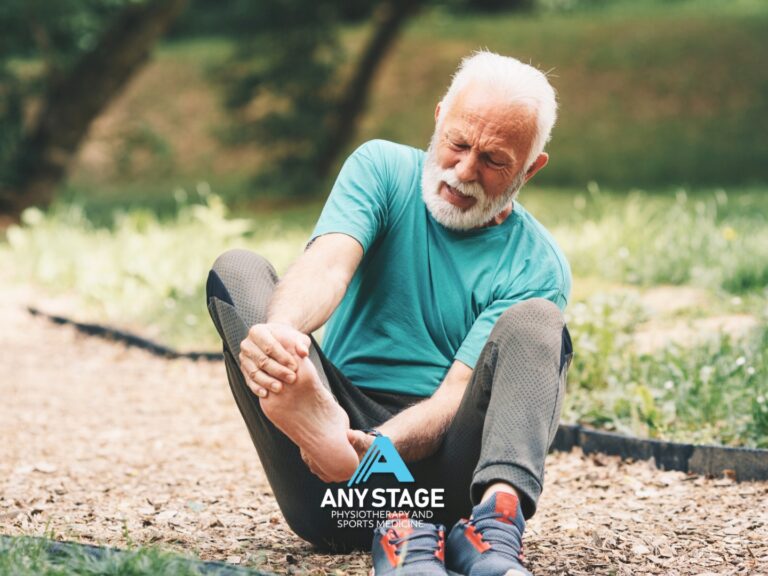What is the meniscus and how is it injured?
The meniscus is a C-shaped piece of fibrocartilage that sits between the femur (thigh bone) and the tibia (shin bone) in the knee joint. There are two menisci in each knee joint, the medial meniscus on the inside of the knee and the lateral meniscus on the outside of the knee. The menisci serve as shock absorbers and help distribute weight evenly across the knee joint.
The meniscus can be injured with movements involving a twisting or rotating force on a partially bent knee. This happens most often during sports activities, such as basketball or soccer, where sudden changes in direction or pivoting movements are common. It can also occur during daily activities, such as lifting heavy objects or stepping awkwardly off a curb.
When an acute meniscus injury occurs, the force causes the meniscus to compress and twist, which can result in the tearing of the cartilage. This tear can be partial or complete and can occur in different areas of the meniscus.
In older individuals, degenerative changes to the meniscus can occur over time, which can make it more prone to tearing with less forceful movements. In this case, a tear can occur during activities as simple as walking or standing up from a chair.
Types of Meniscus Tears
Classified based on the location, shape, and severity of the tear:
- Radial tear: A radial tear is a vertical tear that runs perpendicular to the meniscus fibres. This type of tear can occur anywhere in the meniscus and can be caused by a sudden twisting or pivoting movement.
- Flap tear: A flap tear is a horizontal tear that causes a portion of the meniscus to fold over on itself. This type of tear can cause the knee to lock or catch during movement.
- Bucket handle tear: A bucket handle tear is a vertical tear that runs along the length of the meniscus and causes a portion of the cartilage to fold over like a bucket handle. This type of tear can cause the knee to lock in a flexed position and can be a more serious injury.
- Degenerative tear: Degenerative tears occur over time. This type of tear is more common in older adults and can occur due to repetitive stress or age-related changes to the cartilage.
- Radial tear with meniscus root involvement: This type of tear occurs when the tear involves the attachment of the meniscus to the tibia bone. This can cause instability and further damage to the knee joint.


The location of the tear can also be classified as medial (on the inside of the knee) or lateral (on the outside of the knee). The severity of the tear can be graded as mild, moderate, or severe depending on the extent of the damage to the meniscus.
There are several factors that can increase the risk of a meniscus tear, including previous knee injuries, age-related changes to the cartilage, poor lower limb alignment, and being overweight. Proper warm-up and stretching before physical activity, as well as using proper technique and footwear, can also help reduce the risk of a meniscus tear.
The signs and symptoms of a meniscal injury:
The signs and symptoms of a meniscus injury can vary depending on the location and severity of the tear but commonly include:
- Pain in the knee that can develop suddenly or over time, depending on the type of meniscus injury and how it happened. The pain can be sharp or dull, and is usually pinpoint to the area where the meniscus is injured.
- Swelling in the knee joint may occur and make it difficult to move the knee. If a meniscus is torn, the swelling is generally delayed due to the lack of blood supply in the meniscus.
- Stiffness in the knee with difficulty bending and straightening the leg.
- Locking or catching during movement. This is most common in flap or bucket-handle meniscus tears.
- Popping or clicking sound or feeling in the knee
- Reduced range of movement in the knee.
- Instability or giving way of the knee during movement.
How is a meniscus injury diagnosed?
It is important to note that some meniscal injuries may not cause immediate pain or symptoms. In these cases, the symptoms may develop gradually over time, making it important to seek professional attention if there is any suspicion of a meniscal injury.
Our Physiotherapists will use subjective information such as the mechanism of injury, location of pain and type of pain to then perform a thorough physical examination. A physical examination includes the assessment of function (squat, calf raise, active knee movement) and specific special tests of the knee joint. The subjective and objective assessments are combined to help diagnose a meniscus injury. Imaging such as an MRI, and other diagnostic tests to confirm the diagnosis and determine the best course of treatment may be indicated. This will depend on the level of pain and the function of the knee.
Other structures that may be injured with an acute meniscus tear
The knee is a complex joint, and various injuries can occur simultaneously or contribute to the overall dysfunction of the knee. Here are some common additional injuries that may accompany a meniscus tear:
- Anterior Cruciate Ligament (ACL) Injury: The ACL is one of the major ligaments in the knee that helps stabilise it. A meniscus tear can sometimes occur in conjunction with an ACL tear, particularly if there is a significant force applied to the knee, such as during sports injuries or motor vehicle accidents. Symptoms of an ACL injury include sudden pain, swelling, and instability of the knee.
- Medial Collateral Ligament (MCL) Injury: The MCL is another ligament in the knee that helps provide stability, particularly to the medial compartment (inside) of the knee. Injury to the MCL can occur simultaneously with a meniscus tear, especially if there is a direct blow to the outer aspect of the knee. Symptoms of an MCL injury include pain, swelling, and tenderness along the inner side of the knee.
- Lateral Collateral Ligament (LCL) Injury: While less common, injury to the LCL can also occur alongside a meniscus tear. LCL injuries usually result from a direct blow to the inner aspect of the knee or from sudden twisting motions. Symptoms include pain, swelling, and instability on the outer side of the knee.
- Cartilage Damage: In addition to the meniscus, there are other types of cartilage in the knee joint, such as the articular cartilage covering the ends of the bones. Trauma to the knee, including a meniscus tear, can lead to damage of this cartilage, resulting in pain, swelling, and potential joint stiffness.
- Bone Bruising or Fractures: The impact that causes a meniscus tear can also lead to bone bruising or even fractures in the knee joint. These injuries can cause localised pain, swelling, and difficulty bearing weight on the affected leg.
- Patellar Dislocation or Instability: In some cases, a meniscus tear may be associated with patellar (knee cap) instability or dislocation, especially if there is underlying ligament laxity or muscle weakness around the knee. Symptoms include pain, swelling, and a sensation of the knee cap giving way or shifting out of place.
- The likelihood of a meniscus tear occurring with a subsequent injury depends on the nature and severity of the trauma.
- For example, in cases of sports-related injuries, high-energy traumas, or motor vehicle accidents, there may be a higher incidence of multiple knee injuries occurring simultaneously.
- Studies suggest that meniscus tears are commonly associated with other knee injuries, particularly ACL tears. It’s estimated that up to 60-70% of ACL tears have concomitant meniscus injuries.
Meniscus tears: Do I need Surgery?
It’s essential to thoroughly evaluate the knee joint in cases of suspected meniscus tears to accurately identify any additional injuries. Treatment and rehabilitation plans will vary depending on the specific combination of injuries present and your individual goals. Therefore, a comprehensive assessment by a physiotherapist or orthopaedic specialist, is crucial for effective management.
The type and severity of the meniscal injury can affect the treatment options available, with more severe tears requiring surgical intervention. Physiotherapy and conservative measures are recommended for less severe tears. Surgery may be indicated for flap and bucket handle types of meniscal tears, particularly when the knee is locking. The function of your knee, subsequent injuries and your activity goals are all used to determine whether surgery is viable.
Meniscus tears: General Conservative Exercises
Exercises have been shown to have positive outcomes for pain reduction, improved range and functioning. Exercises for meniscus should focus on strengthening the quadriceps, hamstrings and gluteal complex through a pain free range. Here are several general examples of initial exercises that you may be introduced to. These exercises will be progressed, based on your tolerance and strength:
- Straight leg raises: Lie on your back with one leg straight and the other bent. Tighten the quadriceps of the straight leg and lift it off the ground to hip level. Hold for five to 10 seconds and slowly lower back down. Repeat for 10 to 15 repetitions on each leg.


- Hamstring curls: Lie on your stomach with your legs straight. Bend your knee and lift your heel towards your buttocks. Hold for five to 10 seconds and slowly lower back down. Repeat for 10 to 15 repetitions on each leg. As symptoms improve, weight can be added.


- Calf raises: Stand with your feet shoulder-width apart and lift up onto your toes. Hold for five to 10 seconds and slowly lower back down. Repeat for 10 to 15 repetitions. Progress to using one leg at a time, when strength and tolerance improve.


- Wall squats: Stand with your back against a wall and your feet shoulder-width apart. Slowly slide down the wall until your knees are at a 90-degree angle. Hold for five to 10 seconds and slowly slide back up. Repeat for 10 to 15 repetitions. Progress to using one leg at a time, when strength and tolerance improve and holding for up to 45 seconds.


- Stationary bike: Cycling on a stationary bike can help improve range of motion and strengthen the muscles surrounding the knee joint. Start with a low resistance and gradually increase as tolerance improves.


- Pool exercises: Water provides a low-impact environment that can be helpful for rehabilitating a meniscus injury. Walking or jogging in shallow water, leg lifts, and hamstring curls can all be effective exercises to include in a pool workout.


Meniscus tears: Return to Sport Plan
Returning to sports following a meniscus injury involves a comprehensive rehabilitation process to ensure optimal recovery, reduce the risk of reinjury, and maximise performance. Here is a general outline of return-to-sport criteria, testing, and timeline following a meniscus injury. The information below is a guideline. It is essential to individualise the rehabilitation program based on the athlete’s specific injury characteristics, functional deficits, sport demands, and personal goals:
Phase 1: Early Rehabilitation (0-2 weeks)
- Pain Management: The focus during this phase on reducing pain and inflammation through modalities such as ice, elevation, and potentially anti-inflammatory medications under medical supervision.
- Range of Motion (ROM) Restoration: Initiate tolerable passive and active ROM exercises to prevent stiffness and maintain joint mobility.
- Muscle Activation: Begin activating and strengthening muscles around the knee, including quadriceps, hamstrings, and calf muscles, through isometric and gentle isotonic exercises.
- Weight-Bearing: Gradually progress weight-bearing activities as tolerated, initially using crutches, if necessary, to offload the injured leg.
Phase 2: Intermediate Rehabilitation (2-6 weeks)
- Progressive Strengthening: Advance to progressive resistance exercises targeting quadriceps, hamstrings, hip abductors/adductors, and calf muscles to improve strength and stability around the knee.
- Proprioception and Balance: Incorporate proprioceptive and balance exercises, such as single-leg stance, wobble board drills, and perturbation training, to enhance joint proprioception and neuromuscular control.
- Functional Training: Introduce functional movements and sport-specific drills focusing on movement patterns, technique, agility, and coordination while gradually increasing intensity.
- Cardiovascular Conditioning: Maintain cardiovascular fitness through low-impact activities like swimming, cycling, or using an elliptical machine to minimise stress on the knee joint.
Phase 3: Advanced Rehabilitation (6-12 weeks)
- Sport-Specific Training: Progress to sport-specific training activities. Including running progressions, cutting, jumping, and plyometric exercises, with emphasis on biomechanical efficiency and proper landing mechanics.
- Strength and Power Development: Implement advanced strength and power exercises, such as (but not restricted to) squats, lunges, leg presses, and box jumps, to improve functional capacity and explosive strength.
- Agility and Speed Drills: Incorporate agility drills, change of direction exercises, and speed training to simulate sport-specific demands and improve dynamic movement patterns.
- Gradual Return to Sport Activities: Gradually reintroduce sports-specific drills, simulated game situations, and controlled scrimmages under the supervision and guidance by your Physiotherapist and coach.
- Functional Testing: Perform functional testing to assess readiness for sport participation, including hop tests (single-leg hop, triple hop, crossover hop), agility tests (T-test, 5-10-5 shuttle run), and sport-specific skill assessments.
- Strength Testing: Throughout the rehabilitation process, periodic strength testing is crucial in providing objective data and information related to progressions and deficiencies. Strength testing of the quadriceps, hamstrings, hip abductors/adductors can be measured with a hand-held dynamometer and calf muscle strength measured with an endurance test. All strength testing is compared to the un-injured leg and must be within 10%, before a return to sport progression is made.
Phase 4: Return-to-Sport (12+ weeks)
- Full Contact Practice: Resume full-contact practice sessions and competitive play only when the athlete demonstrates adequate strength, endurance, agility, and confidence in performing sport-specific tasks without pain or functional limitations.
- Specialist Clearance: If the rehabilitation process has been guided by an orthopaedic specialist, a clearance must be obtained before returning to sport. This clearance will confirm the athlete’s readiness to return to sport activities based on clinical evaluation, functional testing results, and imaging findings (if indicated).
- Gradual Return: Gradually increase training intensity, duration, and volume over several weeks to allow the athlete to acclimate to the demands of competition and reduce the risk of overuse injuries or setbacks.
- Ongoing Monitoring: Continuous monitoring of the athlete’s progress, performance, and symptoms throughout the return-to-sport process is critical, adjusting the rehabilitation program and workload as needed to optimise outcomes and prevent reinjury.


Final thoughts
Collaboration among the sports medicine team, including physiotherapists, strength and conditioning coaches, and medical professionals, is crucial for coordinating care and ensuring a safe and successful return to sport following a meniscus injury.
The information provided above is general in nature. If you have experienced a recent meniscus injury, or, you have persistent knee pain, please do hesitate to contact our friendly and experienced team at Any Stage Physiotherapy and Sports Medicine for individualised assessment and information.
We are here to guide you back to a pain-free lifestyle and help return you to sport.
Authors


Daniel Lee
DPT, B. Sc, APAM
Director / Principal Physiotherapist
Daniel Lee has created a specialised approach to Physiotherapy treatment, return to sport and injury prevention by incorporating a functional strength & conditioning approach, no matter the individual’s age, sport, lifestyle, or competition level.

Shannon Murray
DPT, B. HSc, APAM
Physiotherapist
Shannon completed her Doctor of Physiotherapy degree at Macquarie University, after relocating from Queensland, where she completed her Bachelor of Health Science degree. Whilst completing her Doctor of Physiotherapy degree, she gained valuable experience in various setting, including private practice and hospital.









